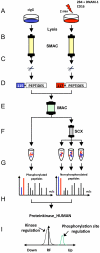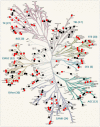Kinome analysis of receptor-induced phosphorylation in human natural killer cells
- PMID: 22238634
- PMCID: PMC3251586
- DOI: 10.1371/journal.pone.0029672
Kinome analysis of receptor-induced phosphorylation in human natural killer cells
Abstract
Background: Natural killer (NK) cells contribute to the defense against infected and transformed cells through the engagement of multiple germline-encoded activation receptors. Stimulation of the Fc receptor CD16 alone is sufficient for NK cell activation, whereas other receptors, such as 2B4 (CD244) and DNAM-1 (CD226), act synergistically. After receptor engagement, protein kinases play a major role in signaling networks controlling NK cell effector functions. However, it has not been characterized systematically which of all kinases encoded by the human genome (kinome) are involved in NK cell activation.
Results: A kinase-selective phosphoproteome approach enabled the determination of 188 kinases expressed in human NK cells. Crosslinking of CD16 as well as 2B4 and DNAM-1 revealed a total of 313 distinct kinase phosphorylation sites on 109 different kinases. Phosphorylation sites on 21 kinases were similarly regulated after engagement of either CD16 or co-engagement of 2B4 and DNAM-1. Among those, increased phosphorylation of FYN, KCC2G (CAMK2), FES, and AAK1, as well as the reduced phosphorylation of MARK2, were reproducibly observed both after engagement of CD16 and co-engagement of 2B4 and DNAM-1. Notably, only one phosphorylation on PAK4 was differentally regulated.
Conclusions: The present study has identified a significant portion of the NK cell kinome and defined novel phosphorylation sites in primary lymphocytes. Regulated phosphorylations observed in the early phase of NK cell activation imply these kinases are involved in NK cell signaling. Taken together, this study suggests a largely shared signaling pathway downstream of distinct activation receptors and constitutes a valuable resource for further elucidating the regulation of NK cell effector responses.
Conflict of interest statement
Figures






Similar articles
-
2B4 (CD244)-mediated activation of cytotoxicity and IFN-gamma release in human NK cells involves distinct pathways.J Immunol. 2001 Dec 1;167(11):6210-6. doi: 10.4049/jimmunol.167.11.6210. J Immunol. 2001. PMID: 11714782
-
Molecular basis for positive and negative signaling by the natural killer cell receptor 2B4 (CD244).Blood. 2005 Jun 15;105(12):4722-9. doi: 10.1182/blood-2004-09-3796. Epub 2005 Feb 15. Blood. 2005. PMID: 15713798
-
Association of a 70-kDa tyrosine phosphoprotein with the CD16: zeta: gamma complex expressed in human natural killer cells.Eur J Immunol. 1993 Aug;23(8):1872-6. doi: 10.1002/eji.1830230821. Eur J Immunol. 1993. PMID: 8344348
-
2B4 dysfunction in XLP1 NK cells: More than inability to control EBV infection.Clin Immunol. 2019 Jul;204:31-36. doi: 10.1016/j.clim.2018.10.022. Epub 2018 Nov 2. Clin Immunol. 2019. PMID: 30391652 Review.
-
2B4 (CD244) is a non-MHC binding receptor with multiple functions on natural killer cells and CD8+ T cells.Mol Immunol. 2005 Feb;42(4):489-94. doi: 10.1016/j.molimm.2004.07.032. Mol Immunol. 2005. PMID: 15607804 Review.
Cited by
-
PBK/TOPK enhances aggressive phenotype in prostate cancer via β-catenin-TCF/LEF-mediated matrix metalloproteinases production and invasion.Oncotarget. 2015 Jun 20;6(17):15594-609. doi: 10.18632/oncotarget.3709. Oncotarget. 2015. PMID: 25909225 Free PMC article.
-
First insight into the kinome of human regulatory T cells.PLoS One. 2012;7(7):e40896. doi: 10.1371/journal.pone.0040896. Epub 2012 Jul 16. PLoS One. 2012. PMID: 22815858 Free PMC article.
-
Evidence for CD16a-Mediated NK Cell Stimulation in Antibody-Mediated Kidney Transplant Rejection.Transplantation. 2017 Apr;101(4):e102-e111. doi: 10.1097/TP.0000000000001586. Transplantation. 2017. PMID: 27906829 Free PMC article.
-
Inositol tetrakisphosphate limits NK cell effector functions by controlling PI3K signaling.Blood. 2013 Jan 10;121(2):286-97. doi: 10.1182/blood-2012-05-429241. Epub 2012 Nov 21. Blood. 2013. PMID: 23175687 Free PMC article.
-
Proteome analysis of distinct developmental stages of human natural killer (NK) cells.Mol Cell Proteomics. 2013 May;12(5):1099-114. doi: 10.1074/mcp.M112.024596. Epub 2013 Jan 13. Mol Cell Proteomics. 2013. PMID: 23315794 Free PMC article.
References
-
- Vivier E, Tomasello E, Baratin M, Walzer T, Ugolini S. Functions of natural killer cells. Nat Immunol. 2008;9:503–510. - PubMed
Publication types
MeSH terms
Substances
LinkOut - more resources
Full Text Sources
Molecular Biology Databases
Research Materials
Miscellaneous

